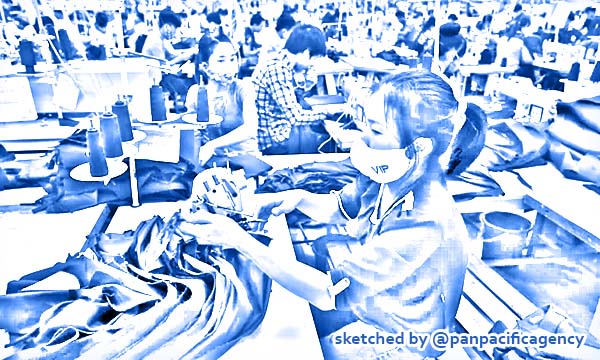Vietnam textiles industry faces localization conundrum

Workers at a garment factory in Bac Giang Province, near Hanoi. Photo by Reuters. Sketched by the Pan Pacific Agency.
HANOI, Jul 25, 2019, VN Express. The Government Office Thursday issued a document conveying the direction of Prime Minister Nguyen Xuan Phuc, who has asked the Ministry of Industry and Trade to work with localities to “resolve obstacles” faced by the local textiles industry in localizing production, reported the VN Express.
According to the document, Vietnam’s textiles producers are currently too dependent on imported raw materials, making it difficult to raise the proportion of domestic added value as required by rules of origin stipulated in trade pacts.
Failure to meet the rules of origin would make Vietnam unable to benefit from preferential tariffs.
To meet the localization conditions, enterprises will have to invest in production facilities in the country as well as in supporting industries, it said.
However, foreign and domestic textiles producers are unable to build new facilities to produce or dye domestic textiles and yarn, because most localities are loath to give them permission due to environmental concerns.
This represents a major disadvantage for Vietnam’s textile industry when the Vietnam-EU Trade Agreement (EVFTA), which was signed in June 30, comes into effect, said Deputy Prime Minister Tran Quoc Khanh at a government meeting in early June.
Representatives of the Vietnam Textile and Apparel Association (VITAS) have also acknowledged that dyeing processes cause environmental pollution, but recommended that localities consider licensing projects with good wastewater treatment technology.
Enterprises investing in such modern technology should be given favorable conditions to build their textiles production plants, VITAS said.
The EVFTA, which has strict rules of origin, generally requires domestic value to account for at least 42.5 percent of the ex-works price of the final textiles product.
If these conditions are met, goods exported from Vietnam to the EU would be subject to 0 percent import duties once the EVFTA comes into effect, and not the average tariff of 9.6 percent currently levied by the bloc.
However, 70 percent of the fabric used to produce garments in Vietnam are imported from mainland China or Taiwan, VITAS chairman Vu Duc Giang said at a conference on the Comprehensive and Progressive Agreement for Trans-Pacific Partnership (CPTPP) late last month.
Because China is not a member of several large trade agreements such as the CPTPP, Vietnam is not able to benefit from cumulation of origin rules, which allows materials originating from countries that are parties to an agreement to make up the deemed domestic value of the final product.
In January 2017, the Vietnamese government set the target of producing 45 percent of fabric needed domestically by 2020, which is equivalent to producing an additional 1.7 billion meters of material, and 65 percent, or 10 billion meters, by 2025.
The government estimates that businesses will have to invest a total of $1.7 billion and $10 billion respectively to meet these targets.